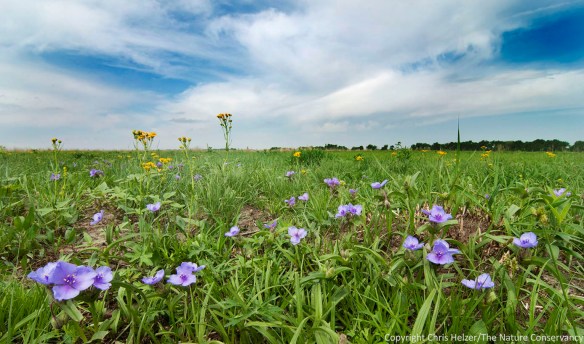I started my annual plant community monitoring this week. That work consists mainly of inventorying the plant species within small sampling plots. Forcing myself to walk regularly spaced transects and stare at a square meter of prairie at a time is a great way to find creatures and sights I might miss if I was just wandering aimlessly. This week, for example, I scared up a couple jackrabbits and found a quail nest within a few minutes of each other, and found a number of pretty neat insects. But in that particular prairie, the star of the show was Tradescantia bracteata (bracted spiderwort), which was scattered across the site in patches about the size of a small car.

A close-up look at a patch of bracted spiderwort, with prairie ragwort (Senecio plattensis) in the background. The Nature Conservancy’s Platte River Prairies, Nebraska. You can click on the photo to see a larger and sharper version.
These spiderworts were blooming in a prairie we planted back in 2000. It has become of our most colorful sites – loaded with wildflowers of all kinds. I didn’t see much spiderwort during the first 5-7 years of the prairie’s establishment (most of which were drought years). Eventually, I started finding a lone plant here and there. Those scattered plants have now formed colonies that radiate outward every year.
If you look closely, you can see that several of the spiderwort plants in this photo have been grazed. They are blooming in a burned portion of the prairie, which is where cattle are focusing most of their attention (within our patch-burn grazing system). Cattle really like to eat spiderwort, so grazing will probably impact the 2013 growth and seed production of the plants in this photo. However, we just finished building a temporary electric fence to exclude cattle from about half of this same prairie for the rest of this growing season, so all the spiderwort patches in that exclosure should have a good year. Next year, the patch of flowers pictured here will get a break from grazing too.
Although grazing can keep spiderwort plants short and decrease seed production, most of this species’ reproduction happens through rhizomes (underground stems), so annual seed production is not critical for its survival or spread. In addition, periodic grazing helps open up space among the grasses and provides opportunities for spiderwort to continue its spread. In fact, areas of our prairies that get little or no grazing tend to have fewer and smaller patches of spiderwort (though the individual plants often grow taller).

The spiderwort up here in the hills are not quite blooming yet…and you can’t blame those cows for grazing it…I seldom can go out without taking a small sample for myself to chew on. They are delicious. SS
Glad to learn how spiderwort spreads. Thanks!
Deer love them too and quickly find the clumps with the most blooms! They seem pretty adaptable as I have some on my mowed path with flowers inches off the ground.
Here in our wild home garden in north Texas we’ve grown a related species of spiderwort for many years. Here it sprouts in early spring from a mass of rhizomes that have spread throughout a large area of open garden and also volunteers in flowerpots where it can easily crowd out the intended plants in a year or two if not discouraged. They are extremely healthy, have no evident insect pests or diseases, and we have no cows to crop them. Haven’t tried tasting them myself, but now I may! By hot summer they die entirely into the ground, mostly replaced by ruellia, another native Texas wildflower. Not a plant for the tailored landscape, but wonderful in a wildscape. And they can even be used for cut flowers, albeit a bit shaggy. Cut and brought into the house, each stem will keep on opening new flowers in the stem-end cluster for up to a week or more, every day. And they don’t wilt in vases. I mix them with snapdragons and roses for a really eclectic floral arrangement.
Note: Some of our spiderworts bloom pink instead of blue. I don’t know if this is natural or if they are from a store-bought variety. Both colors seem about equally well adapted to growing here.
John, I’ve read where Spiderwort can be used as an environmental indicator of air quality, changing from blue to violet when quality declines, as well as an indicator of low levels of radiation exposure, which cause the stamens to turn pink.
I’ve never heard the air quality thing. Might be possible, but it’s sure not the only driver of spiderwort flower color. I’ve got blue, violet, and white in my yard. All came from the wild and all seem to be genetically linked (seeds from each color produce plants with the same color). There was a pretty good variation in the blue-violet-pink continuum in the prairie I photographed the other day. I assume air quality was fairly consistent across that 80 acres…
Chris,
A quick Google search brings up the links below, as well as many others… a lot in Europe. I personally haven’t read any academic papers on the topic, yet. The Dave’s Garden link below mentioned the Spiderwort appears to be capable of detecting levels of radiation that cannot be detected by modern equipment. I agree that it can’t be the only driver of color, but interesting nonetheless.
http://davesgarden.com/community/journals/viewentry/118956/
http://www.sierrapotomac.org/W_Needham/Spiderwort_050626.htm
http://redrockcanyonopenspace.org/education/biology/spiderwort/